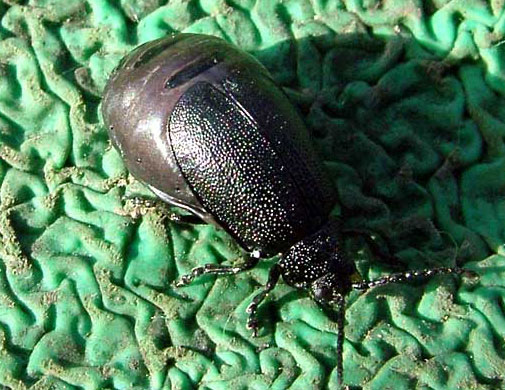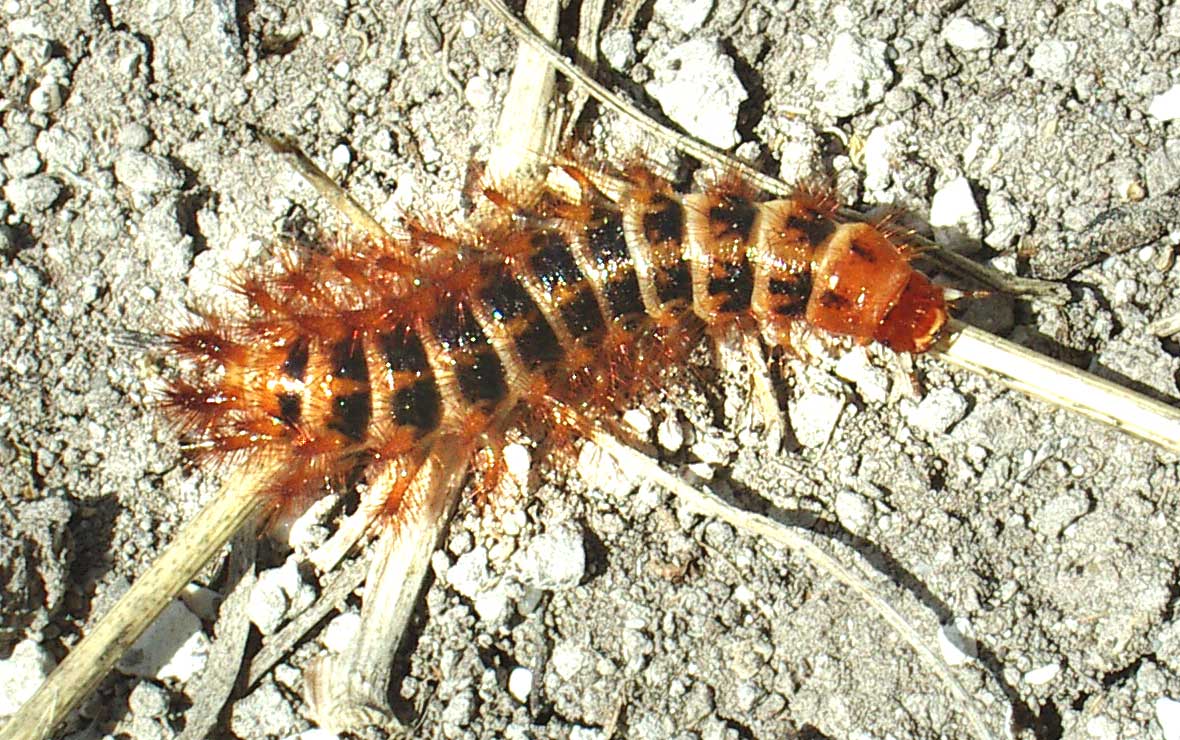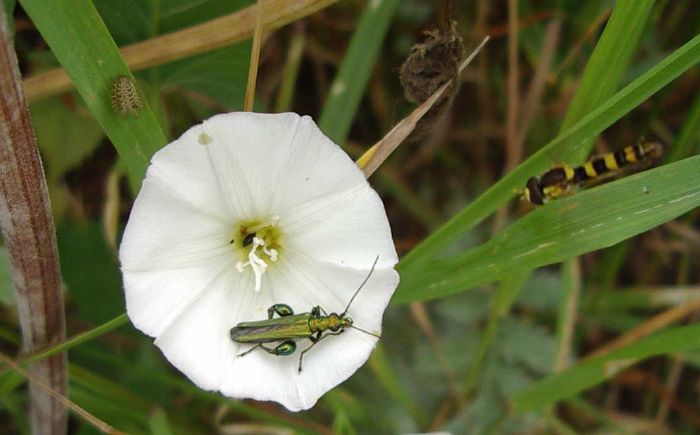-
Adur Terrestrial Beetles
This
is a miscellaneous selection rather than a representative sample. Beetles
were only recorded as incidentals or because they were large and noticeable.
Ladybirds
have their own page.
More
Beetles 2006
27
May 2006
This
little
red beetle was spotted on the Sompting
Brooks, where the gardens meet the wild
strouds.
It is only about 6 mm long.
It
is
Endomychus coccineus
and it is sometimes called the False Ladybird.
It
feeds on the fungus
on the bark of rotten deciduous trees. The
beetle has four spots (shown clearly in book illustrations and most photographs)
and
it is just the angle this photograph was taken at that makes it look it
has just two.
Identification
by Malcolm Storey (BioImages)
on
the British
Insects Yahoo Group |
 |
18
May 2006
The
first very small Thick-legged Flower Beetle, Oedemera nobilis,
of the year was seen on a Bulbous Buttercup
on the Slonk Hill Cutting (south bank).
9 April
2006
The
beetles Paederus
littoralis
were
still present under the discarded Chestnut fencing on the Pixie
Path.
 18
January 2006
18
January 2006
Under
the discarded Chestnut fencing on the Pixie
Path, most of the dozen wood lice
and a few spiders
scampered off too quickly for the camera. One colourful Rove
Beetle (Staphylinida) was slower and is shown
on the left. There were three or four of these flightless beetles known
as Paederus
littoralis.
The
book (Chinery) says that this beetle is to be
found in damp places. The specific name rather indicates the shore. These
beetles contain a fluid called paederin which can cause the
skin to peel and is more serious if it comes into contact with your eyes.
There are examples of serious
dermatitis caused by this substance (Beetle Juice). The
front of the abdomen is called the elytra.
The
identification has not been confirmed, but it seems probable. The British
species of the same genus are:
Paederus
caligatus Erichson, 1840
Paederus
fuscipes Curtis, 1826
Paederus
littoralis
Gravenhorst, 1802
Paederus
riparius (Linnaeus, 1758) The
specific name indicates a river.
This
is a hardy species and one specimen has survived 22 days to 2
March 2006 in an airtight container (35mm
film capsule) without food or water.
 |
14
September 2005
This small beetle
crawled over the herbs, grass and rabbit droppings just north of the Reservoir,
Mill
Hill. The habitat contained Yarrow leaves,
the reported food plant of this beetle. On other parts of the hill
Yarrow
was
in flower.
It was not measured so its
total length of 17 mm is a rough estimate only.
The
beetle in the photo is certainly Galeruca
tanaceti.
It feeds on Tansy
and possibly Bedstraws
too, as far as I can tell. Galeruca tanaceti
is widespread
but local.
|
In
early July I recorded Galeruca tanaceti
in
Bushy
Park in large numbers, and in 2000
it
was prevalent. It seems to be associated
with
Knapweed Centaurea
sp.
|
I
would certainly have no hesitation in determining this beetle as
Galeruca
tanaceti. They are probably associated
with a number of
different
plant species. For example, I have frequently found adults
eating
Devil's-bit
Scabious and sometimes even Creeping
Thistle,
although
Yarrow
is perhaps its favourite.
It
is widespread on the more open parts of the South
Downs in East
Sussex
and also sometimes occurs in heathy grassland, occasionally undergoing
population explosions. A good time to search is in September
or October.
|
7 August
2005
Theis
larva was discovered in the Hawthorn wood/scrub in the north-west of
Mill
Hill. The multiple-legged insect, a larva (not a centipede),
was crawling towards the right of the photograph. It seems to have eleven
segments. It was crawling over the path between the northern end of the
lower
slopes and the stile. It may be a beetle larva. It estimated length
is 25 mm. This may be the larva of Drilus
flavescens, which is frequent on the
downs in southern coastal areas.
I think
this must be a Drilus larva. It looks just like the diagram
in Westwood's book. (Richard Jones)
13
July 2005
A female
Stag Beetle, Lucanus cervus, was
spotted crawling slowly across the pavement outside Lidls store in Worthing
next to a busy road. As it was in imminent danger of being squashed, it
was transferred to a garden in Lancing.
| 7
July 2005
This
very small (under 10 mm estimated size) insect was sheltering on a dried
put piece of Horsehair. |
|
| 3
July 2005
This
small beetle crawled out of the Sunday paper: Lagria
hirta ? |
|
| 22
May 2005
This
beetle was under a large flint rock on the northern bank of Slonk
Hill Cutting. |
 |
Mill
Hill: Vetch Trail
15
May 2005
A
shiny green
Cryptocephalus
beetle was noted on a Bulbous
Buttercup. |
 |
 |
24
April 2005
The
small black beetles are species of pollen beetles, Meligethes.
Meligethes
aeneus is the commonest species breeding on Oil
Seed Rape and other yellow Brassicas,
though it is also found feeding widely on other flowers. Meligethes
viridescens is considerably less common on Rape
etc but widespread.
Horseshoe Vetch is the
host of Meligethes erichsoni There are 36 species of Meligethes
in Britain. Though they can be identified with the excellent Royal
Entomological Society Handbook on Pollen Beetles, they are superficially
very similar and generally require close examination and dissection for
correct identification. Host plants are useful guides, but many species
can also be found feeding as adults on plants which are not their true
hosts.
Royal
Horticultural Society web page on Pollen Beetles (Meligethes species)
Checklist
of UK Recorded Nitidulidae |
 |
Meligethes aeneus
is the commonest pollen beetle species breeding on Oil
Seed Rape and other yellow Brassicas,
though it is also found feeding widely on other flowers. Meligethes
viridescens is considerably less common on Rape
etc but widespread.
|
 |
21
September 2004
Above
the ridge on the upper slopes of Mill
Hill, a Devil's Coach-horse Beetle,
Staphylinus
olens,
crawled into shelter, its large
and rather ominous-looking body quickly disappeared from view.
This
beetle has jaws that can pierce human skin and can also squirt out noxious
and irritating chemicals from its rear end.
14
October 2004
A black
Devil's
Coach Beetle was seen crawling near the
top of the slopes of Mill Hill.
Rove
Beetle, Ocypus
British
Staphylinidae Key |
 |
12
July 2004
The
prevalent small orange beetles seen on Mill
Hill are Rhagonycha fulva
(a Soldier Beetle, Cantharidae). This abundant species is probably seen
on many bits of wasteland. They seem associated with Hardheads
(Lesser Knapweeds), but in the photograph
on the right, you can judge their small size on Bird's
Foot Trefoil. |
 |
11
June 2004
Slonk
Hill South Bank
The
small metallic green beetle found frequently on the Kidney
Vetch, Ox-eye Daisies, Spotted Orchids
and other plants is the Thick-legged Flower Beetle, Oedemera
nobilis. NB: the book common name is also
Swollen-thighed Beetle which can be seen in the photograph. There is a
similar smaller green beetle called
Oedemera
lurida. There was another small green beetle present that lacked the
swollen thighs, or thick legs. This is the
female of Oedemera
nobilis. The brown insect was a Squash
Bug, Coreus marginatus (pic). |
Sussex
Pad to Hoe Court Cottages
 9
June 2003
9
June 2003
The
Stag Beetles were active at dusk flying
over my south Lancing garden (TQ 186 044).
One
of them was chased by a Blackbird.
Link
to Adur Water Beetles
Adur
Ladybirds
British
Beetles Yahoo Group
The
Coleopterist
Adur Insect Links:
Bumblebees
Hoverflies
Butterflies
Solitary
Bees
Adur
Bees, Wasps & Sawflies
Flies
Water
Beetles
Ladybirds
Moths
Grasshoppers
& Crickets
Damselflies
&
Dragonflies

























